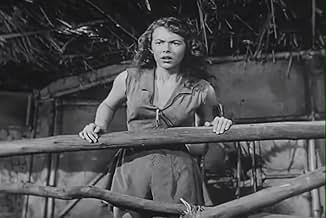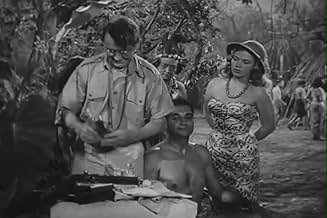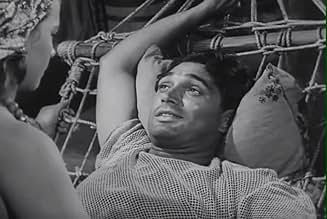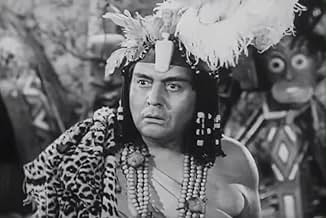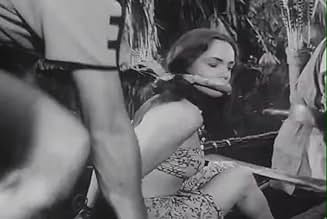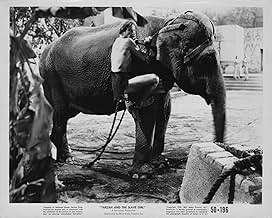IMDb-BEWERTUNG
5,6/10
701
IHRE BEWERTUNG
Als Jane entführt wird, findet Tarzan sie bei den Löwenkriegern, die an einer ansteckenden Seuche leiden. Eine Krankenschwester verliebt sich in Tarzan und wird dadurch zu Janes gefährlicher... Alles lesenAls Jane entführt wird, findet Tarzan sie bei den Löwenkriegern, die an einer ansteckenden Seuche leiden. Eine Krankenschwester verliebt sich in Tarzan und wird dadurch zu Janes gefährlicher Rivalin, als beide erneut gekidnappt werden.Als Jane entführt wird, findet Tarzan sie bei den Löwenkriegern, die an einer ansteckenden Seuche leiden. Eine Krankenschwester verliebt sich in Tarzan und wird dadurch zu Janes gefährlicher Rivalin, als beide erneut gekidnappt werden.
- Regisseur/-in
- Autoren
- Stars
Anthony Caruso
- Sengo
- (as Tony Caruso)
Shirley Ballard
- Slave Girl
- (Nicht genannt)
Trevor Bardette
- Man Building Tomb
- (Nicht genannt)
George Barrows
- Lionian
- (Nicht genannt)
Ray Beltram
- Nagasi Brave
- (Nicht genannt)
Rosemary Bertrand
- Slave Girl
- (Nicht genannt)
Paul E. Burns
- Courier
- (Nicht genannt)
Gwen Caldwell
- Slave Girl
- (Nicht genannt)
Fred Carson
- Nagasi Brave
- (Nicht genannt)
Allen Church
- Lionian
- (Nicht genannt)
Martha Clemons
- Slave Girl
- (Nicht genannt)
5,6701
1
2
3
4
5
6
7
8
9
10
Empfohlene Bewertungen
Denise Darcel Steals Every Scene!
Out of all the Lex Barker Tarzan movies, I love this one the best because of Denise Darcel. She plays Lola, a feisty, buxom beauty who steals every scene she's in! Her sassy ways and sharp tongue gets her in a lot of trouble, but she doesn't care. She sets her sights on any handsome man she sees and isn't reluctant to let them know she's interested. Darcel's character is funny, too. She gets into a fight with Jane and gets tossed around the room! Too funny! It was nice to see a Jane who could handle herself, but there was no chemistry between this Jane and hunky Tarzan. The jungle trip to the secret city is also very good because it's creepy and full of suspense. In my opinion, it's one of the best!
It's Tarzan, what do you expect?
Watching this Tarzan movie can be a multi-cultural experience. Tarzan and Jane are of English extraction living in Africa, which as usual looks more like a South American rain forest. One of the native tribes here is black, but others look more like South Pacific islanders, or just bronzed Caucasians. There's an Irish doctor who is assisted by a feisty Latin nurse. The tribe that's capturing slaves has a culture that looks vaguely Egyptian, but they're building a temple that is more Mayan with the help of Indian elephants, which respond to Tarzan's famous yell just like the African ones. Finally, the captured slave girls resemble Veronica Lake or Linda Darnell and dress like Dorothy Lamour.
Of course, everyone knows what they're getting with a Tarzan movie, which are not examples of cultural, geographical or political correctness. Lex Barker in the title role is almost interchangeable with Johnny Weissmuller. Vanessa Brown, in her only appearance as Jane, is lovely but might seem a bit too young and dainty for some tastes, though she does handle herself pretty well in a fight with Lola the nurse. If you're ever overcome with a wave of nostalgia you may want to watch this.
Of course, everyone knows what they're getting with a Tarzan movie, which are not examples of cultural, geographical or political correctness. Lex Barker in the title role is almost interchangeable with Johnny Weissmuller. Vanessa Brown, in her only appearance as Jane, is lovely but might seem a bit too young and dainty for some tastes, though she does handle herself pretty well in a fight with Lola the nurse. If you're ever overcome with a wave of nostalgia you may want to watch this.
Hollywood Swinging
Lord of the jungle Lex Barker (as Tarzan) and leggy mate Vanessa Brown (as Jane) are riding the elephant when they happen upon a damsel in distress. As it turns out, she's been kidnapped by a tribe of "Lionians" who like to make slaves of attractive women. When a mysterious disease threatens everyone in the area, Mr. Barker brings doctor Arthur Shields (as E.E. Campbell) into the picture. Tagging along are his full-figured blonde nurse Denise Darcel (as Lola) and her boozy boyfriend Robert Alda (as Neil). The former does everything she can to get into Barker's loincloth, and the latter provides Cheeta with another drunk scene...
Eventually, Ms. Brown and Ms. Darcel are abducted into the slave harem, which is run by handsome Hurd Hatfield, the Prince of the Lionians. Again, Darcel indicates her readiness for a good-looking male. Former silent screen star Robert Warwick is the tribe's high priest. But the lead villain is Anthony "Tony" Caruso (as Sengo), who keeps stroking his scar and dreaming of Brown. Fortunately for romantics, Barker and Brown remain true to each other. This was Brown's only appearance as "Jane" in the series, with rotating mates becoming the norm. She, Darcel, and the scantily-clad harem girls provide a lot fodder for sexual fantasy.
***** Tarzan and the Slave Girl (6/21/50) Lee Sholem ~ Lex Barker, Vanessa Brown, Denise Darcel, Anthony Caruso
Eventually, Ms. Brown and Ms. Darcel are abducted into the slave harem, which is run by handsome Hurd Hatfield, the Prince of the Lionians. Again, Darcel indicates her readiness for a good-looking male. Former silent screen star Robert Warwick is the tribe's high priest. But the lead villain is Anthony "Tony" Caruso (as Sengo), who keeps stroking his scar and dreaming of Brown. Fortunately for romantics, Barker and Brown remain true to each other. This was Brown's only appearance as "Jane" in the series, with rotating mates becoming the norm. She, Darcel, and the scantily-clad harem girls provide a lot fodder for sexual fantasy.
***** Tarzan and the Slave Girl (6/21/50) Lee Sholem ~ Lex Barker, Vanessa Brown, Denise Darcel, Anthony Caruso
Tarzan saves slave girls from evil cult is more Flash Gordon than a jungle adventure
This Tarzan installment seemed particularly goofy, with Tarzan, Lex Barker in his second outing as the Lord of the Jungle, finding himself at odds with a pointy hat wearing cult who capture Tarzan's slave girl friends. The silly looking costumes, the strange temples, the scantily clad women made this installment feel more like a Flash Gordon serial than it did a Tarzan jungle adventure film. It's not bad and I'm sure it would still appeal to kids and adults who enjoy the other Tarzan films, but the story and action here seemed incongruous and far afield from prior films or the Edgar Rice Burroughs source material. At least this one did not prominently feature racist stereotypes of African native people.
I remember Jane
I was 10 when i saw this movie. It was the first Tarzan movie I had ever seen.I fell in love with Vanessa Brown. I thought she was the most beautiful woman I had ever seen. I would go home and pretend I was Tarzan, defending her from lions and crocodiles. Unfortunately, I seem be the only one who remembers her so fondly. I wish I knew where I could get a copy of this movie or even a photograph of her in her Jane outfit.This actress indeed brings back fond memories of my childhood.
Wusstest du schon
- PatzerThe "sound effect" of a warbling jungle bird, heard throughout this film, sounds suspiciously like the work of a human bird caller, rather than the call of an actual avian creature.
- VerbindungenFeatured in Biography: Tarzan: The Legacy of Edgar Rice Burroughs (1996)
Top-Auswahl
Melde dich zum Bewerten an und greife auf die Watchlist für personalisierte Empfehlungen zu.
- How long is Tarzan and the Slave Girl?Powered by Alexa
Details
- Laufzeit
- 1 Std. 14 Min.(74 min)
- Farbe
- Seitenverhältnis
- 1.37 : 1
Zu dieser Seite beitragen
Bearbeitung vorschlagen oder fehlenden Inhalt hinzufügen

